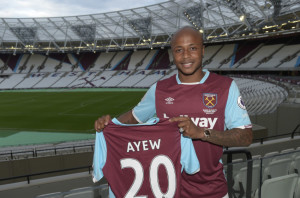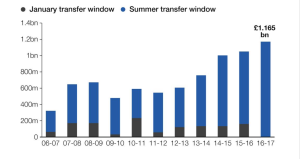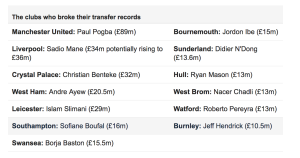I want to talk to you about Craig Bellamy and Andrew Ayew. If you’re not a big fan of English Premier League you’re probably wondering who those two guys are, and what could possibly make them interesting enough to talk about.

NORWICH, UNITED KINGDOM – JULY 31: (Photo by Matthew Lewis/Getty Images) *** Local Caption *** Craig Bellamy
Photo Credit: Arfa Griffiths via Getty Images
Well, they are both footballers who play the same position. Bellamy is retired, and Ayew plays currently for the London-based soccer club West Ham United where Bellamy used to play. They are interesting because they represent the effect of an insane revenue boom in the EPL, and how that has changed the economic dynamics of the one of the most popular sports leagues in the world.
In 2016, the EPL penned a new £5.13 billion broadcast rights deal which rose more than £2 billion from the previous agreement. This money is then spread amongst all the teams in the league. Imagine the EPL as a nation, and their GDP just swelled in size because the G, in this scenario the league itself, just poured a bunch of money into every team.
In past years, we have seen increases in I, or individual investment, in past years when billionaire oil magnates bought teams and injected them with loads of cash i.e. Chelsea and Manchester City, but those moves didn’t affect spending trends league wide. This time, the money has been helicoptered into small teams like Watford, as well as the giants like Manchester United. And unlike in Japan, those teams sure have spent that money.
This past summer alone teams in the EPL spent over a £1.165 billion on transfers. Trumping the gross spend from the previous summer of £870 million, and continuing an astonishing upward trend from the start of the window in 2003, in which teams outlayed a “paltry” £235 million.
Chart Source: Deloitte
Why is this happening? If we look at it through the lens of economist David Ricardo’s theory of marginal rents we can glean insight into why the trend of transfer spending has spiked so fantastically. I would point to those players and clubs on the “margin”, basically those teams that are average performers in the league, to see why spending continues to rise throughout the league.
Look at the number of record transfers that happened this past window, and then notice the spike in spending by the four teams in the chart on the right. The reason why those teams must spend even more now is because what the average team will pay for the average player has skyrocketed, and driven up the cost of players for those at the top of the league.
This brings me back to our old friends Andrew Ayew and Craig Bellamy. You can see Ayew’s name on that chart next to the £20.5 million he cost this past summer. Back in the summer of 2007, Bellamy, a player of a very similar skill-level and position, came to the same club for £7.5 milion. That is a huge jump in what that team would pay for that player in a mere eight years, and if we look at Ricardo we know that if the team on the “margin” can pay £20.5 million then that drives up the what the good clubs play for good players, and then what the elite clubs must pay for elite players. Thus creating the new market value for all players and the record spending for the clubs. After all, clubs still need players to sell tickets and TV rights.
This appears to be the new reality in the Premier League, and fans will have to get used to the dizzying amount of pounds spent on footballers as the trend continues to skyrocket.




Leave a Reply
You must be logged in to post a comment.